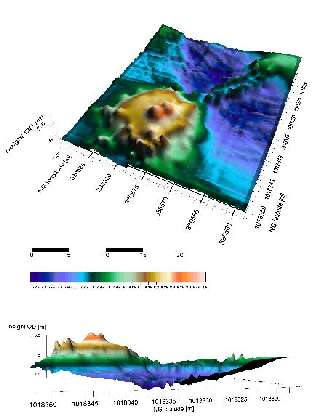Sandra
Eldrum
Diplom Physikerin/MScR Physics
MA
Archaeological Practice
homepage:
http://se.anomic.de

Publications/Contributions

Talks:
Experimental/Nuclear Physics, Orange detector:
orange.pdf
Archaeological Geophysics, general investigations on artificial islands/Crannogs:
crannogs.pdf
Abstracts:
Diploma thesis in Experimental Nuclear Physics
The inner conversion
is a process in competition with gamma emmission and therefore a
useful alternative to low energetic transitions inside the Compton
continuum of a gamma germanium detector, and when gamma decay is less
probable then conversion. The Orange Spectrometer was rebuild and
setup at the Cologne Institute for Nuclear Physics in 2004/5 after an
overall technical obsolescence that took over 3 years with more than
a dozen people involved.
The energy resolution that can be
achieved after focusing the electrons into a scintillator crystal
through a varying magnetic toroidal field is about 0.8 % at 180 keV
which equals 1.5 keV.
Title: Conversion electron
spectroscopy at the Cologne Tandem-accelerator: Setup und test of the
big Orangen spectrometer and measurements on 180Ta and 195Au. Diploma
thesis of the faculty of mathematical and natural sciences 10th
August 2005, Institute for nuclear physics, University of Cologne,
Germany Sandra Christen
Abstract
The content of this Diploma thesis
generally was and is the coordination and documentation of the
re-setup of the 'Orange' spectrometer, which had been designed by E.
Moll and build by the company 'HAEREUS'. It is an electron-focusing
magnetic spectrometer that, during the work for this thesis, has been
setup at the R30 beam-line of the Cologne Tandem-van de Graaf
accelerator. The spectrometer had formerly been in use at the GSI
Darmstadt (before 1997) and at the Bonn cyclotron (between 1997 and
2001) with magnetic focusing strengths of up to 800 keV conversion
energy. Therefore, part of my work related to the coordination of the
works for the technical transformation of the geometry and its
adjustment in relation to the beam-line, the extention of the field
currents of up to 1200 keV, the renewal of the steering- and
analysing software, the concept of a security automatisation1, issues
of influences of magnetic disturbances by beam steering lenses,
vacuum systems, avoidance of iron-containing parts, as well as the
finalizing optimisation of the electronic parameters and the
adjustment of the ideal source point, statically and 'in-beam' and
the related elimination of problems during the focusing of the
accelerator beam. The results of test measurements revealed a
resolution of the apparatus to be 0.8 % at an electron energy of 181
keV, which equals an error of 1.5 keV. After the measurements, which
lasted from January until April with an addition of July in 2005, the
data was analysed to release some interesting knowledge about the
pre-adjustment of the spectrometer and about the method of analysis,
resulting in three new transitions in 195Au, two of which could
already be related to known levels, while the term scheme could be
enhanced and corrected. In the following, first chapter, the theory
of conversion electron spectroscopy will be explained along the
general explications of R. Reinhard, K. S. Krane, und J. L. Wood 2,
while in the following, second chapter, the theory of the re-setup of
the Bonn Orange spectrometer at the Cologne Tandem accelerator and a
re-assessment of the method of measurement and the analysing software
will be given. The theoretical calculations for the magnetic field
generating coil system generally rely on the work of E. Moll, while
the presentation of the energy calibration is based on the
considerations of K. Siegbahn. In the third, and last chapter, the
measurements will be presented and the results will be discussed,
followed by a visitation of the theoretical formalism of the
super-symmetric IB(FF)M model and the measurements of the
super-symmetric nucleus of 195Au. Finally, an outlook on future
fields of duty of the spectrometer, and a summary of the content of
this diploma thesis will be given. 1 Observation and automated alarm
system of temperature and vacuum, fast closing valves, barometer,
current velocity guardian, etc. 2 uncited passaged should be taken as
comments.
Thesis:

Master of Arts in Archaeological Practice
Title: Waterland–People:
On Structure and Origin of Crannogs
Geophysical and Environmental Evidence in Orkney
Dissertation Master of Arts in Archaeological Practice 12/09/2008, University of Highlands and Islands Orkney College Department of Archaeology
Sandra Christen
Abstract
Crannogs have been a target object of theoretical approaches, sourrounded by mysteries concerning their origin since their discovery in the 19th century.
Investigations comprised from large scale excavations to random sampling with few
geophysical surveys and a range of theories concerned with their structural identity.
The Islands of Orkney provide an excellent environment in which a framework for local communities studies can be set up which helps finding patterns in the information of the site types crannog and other island settlements, of which there are more than 30 possible only on Mainland.
An attempt is made in this work to find reasons for the patterns associated with crannogs and other island–type settlements by looking at their possible origins in the Mesolithic through detailed environmental and a critical historical research, their structural evidence using geophysical instrumentation on the exposed surface as a first step and by comparison with similar sites in the world wide record.
Since the geophysical approach is relatively new, the practicability of such approaches
is studied in detail and an evaluation of its application to different site types is given in order to estimate the value of a site fingerprint.
The conclusion is that site patterns and structural evidence (although sparse at this stage) give hints to their origins which are manifest in beliefs that emerged from observations and perceptions of humanity in the late Holocene and that these origins can be projected into different phases of civilization, all related by some few variables such as water, continuity, supply and, perhaps, transformation.
The first chapter introduces the approach, taken throughout the entire work and the second chapter unrolls the history of previous research generally, critically and in an european context, it also provides an insight in the main objectives of this work.
Chapter 3 assesses the sites localized in Orkney and chapter 4 introduces the geophysical methods used during fieldwork.
The succeeding chapter 5 gives and investigates the geophysical results in their context while chapter 6 discusses all results along the line of some related aspects.
The conclusion extracts from the local Orkney scale and projects by including all
findings, onto a general, spacially and chronologically independent, scale, which is the topic of the final chapter 7. An outlook that offers future objectives and a summary, that reassesses the preliminary aims and objectives follow. The appendices comprise of abbreviations, site lists and a photographic register.
Dissertation:

YACY!
The alternative search-engine

Loklac and SUSI
Your personal AI-Assistant
(mind you, SUSI.ai is a newborn, currently acting like a baby - AI,
but it will learn.. watch this space..

|
Solar
X-rays:
Geomagnetic Field:
|

|
|
 > >
|
|
|
|
From
n3kl.org
